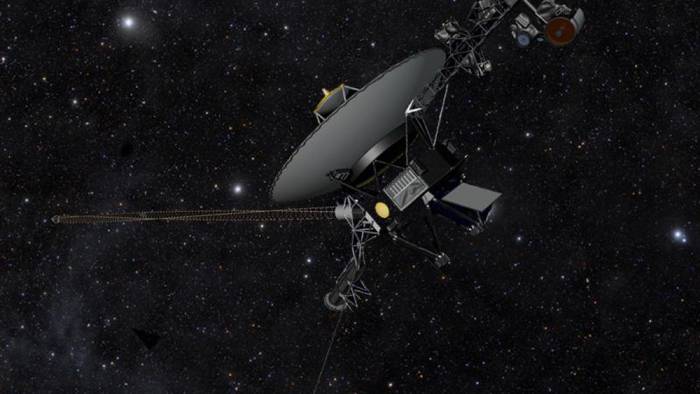The Voyager spacecraft are nearing the end of their journey after more than 44 years of travelling farther from Earth than any other man-made object.
Both Voyagers launched from Cape Canaveral in 1977, with Voyager 2 being the first to do so, taking advantage of a once-in-a-176-year alignment of Jupiter, Saturn, Uranus, and Neptune to rocket into interstellar space.
They were meant to survive five years to study Jupiter and Saturn, but despite escaping beyond the heated plasma bubble known as the heliopause, which marks the beginning of our solar system’s edge, both spacecraft are still operational.
“We’re at 44 and a half years, so we’ve done 10 times the warranty on the darn things,” NASA scientist Ralph McNutt told the magazine Scientific American about shutting down the probes.
Both spacecraft are powered by radioisotope thermoelectric generators (RTGs), which use the heat from decaying plutonium spheres to generate electricity, albeit the RTGs’ output is falling by roughly four watts each year.
This means that each instrument is turned off one by one.
Voyager 1 has only four operational instruments left, whereas Voyager 2 has five.
The plutonium that powers the spacecraft will undoubtedly deteriorate past the point where it can keep the probes operational. Some predict it will happen as soon as 2025, while others believe it will happen later.
However, they have so far shocked NASA engineers, who had anticipated to begin turning off Voyager 2’s equipment one by one beginning in 2020. Since 2008, however, nothing has been turned off.
“If everything goes really well, maybe we can get the missions extended into the 2030s. It just depends on the power. That’s the limiting point, ” In an interview with Scientific American, Linda Spilker, who started working on the Voyager missions before they launched, remarked.
Getting out of the solar system
Voyager 1 took 36 years to cross the heliopause, and the data it has returned since then has revealed some fascinating aspects about the significance of magnetic fields in the universe.
Voyager 2 then entered interstellar space in 2018, 41 years after its launch, bursting through the heliopause’s outer limit, where the hot solar wind collides with the cold interstellar medium.
However, space is vast, and neither of the probes is currently thought to be outside the solar system. The Oort Cloud, a collection of tiny objects still subject to the gravity of the Sun, is thought to represent the last frontier.
Voyager 2 will take around 300 years to reach the inner edge of the Oort Cloud, and maybe 30,000 years to travel beyond it, according to NASA.
Voyager 1 is currently 14.5 billion miles (23.3 billion kilometres) from Earth, and travelling that distance takes 20 light hours and 33 minutes, implying that sending a message to the spacecraft and receiving a response takes two days.
Voyager 2 isn’t quite as far away, at about 12 billion miles from Earth and less than an hour’s light distance.
Both spacecraft are equipped with a gold-plated disc with multicultural greetings, songs, and images in case they encounter intelligent life – however some astronomers have warned that making initial contact may be a mistake.
Carl Sagan was concerned about this: “The fact is, for better or for worse, we have already announced our presence and location to the universe, and continue to do so every day.
“There is a sphere of radio transmission about thirty light years thick expanding outward at the speed of light, announcing to every star it envelops that the earth is full of people.
“Our television programmes flood space with signals detectable at enormous distances by instruments not much greater than our own. It is a sobering thought that the first news of us may be the outcome of the Super Bowl, “he penned.
Data that is mysterious
Last month, NASA announced that its engineers were working on a mystery affecting Voyager 1’s telemetry data, despite the fact that Voyager 2 is still operating correctly, albeit with several equipment shut off for longevity.
The attitude articulation and control system (AACS) of the problem probe is in responsible of the spacecraft’s orientation, which includes maintaining the antenna pointed properly towards Earth so it can relay data home.
This data is still flowing, indicating that the AACS is functioning properly, but NASA says that the telemetry data is invalid. According to the space agency, it looks to be randomly created or not representing any probable state in which the AACS could be.
“A mystery like this is sort of par for the course at this stage of the Voyager mission,” said Suzanne Dodd, project manager for Voyager 1 and 2 at NASA’s Jet Propulsion Laboratory in Southern California.
“The spacecraft are both almost 45 years old, which is far beyond what the mission planners anticipated. We’re also in interstellar space – a high-radiation environment that no spacecraft have flown in before.
“So there are some big challenges for the engineering team. But I think if there’s a way to solve this issue with the AACS, our team will find it,” Ms Dodd added.
The Legacy
As Voyager 1 passed Uranus on February 14, 1990, it returned to Earth to capture a picture of our planet as a tiny dot.
Four years later, astronomer Carl Sagan spoke to an audience at Cornell University on the significance of the photograph, notably coining the phrase “Pale Blue Dot” and giving one of the most extensively reprinted lectures of all time.
“Consider again that dot. That’s here. That’s home. That’s us. On it everyone you love, everyone you know, everyone you ever heard of, every human being who ever was, lived out their lives.
“The aggregate of our joy and suffering, thousands of confident religions, ideologies, and economic doctrines, every hunter and forager, every hero and coward, every creator and destroyer of civilisation, every king and peasant, every young couple in love, every mother and father, hopeful child, inventor and explorer, every teacher of morals, every corrupt politician, every ‘superstar’, every ‘supreme leader’, every saint and sinner in the history of our species lived there – on a mote of dust suspended in a sunbeam.”
It’s unlikely that they’ll see something like it again very soon.
While the cameras can be turned back on, NASA says that doing so isn’t a priority for the interplanetary journey.
The photograph would also be nothing near as nice as the one taken in 1990, according to the agency: “It is very dark where the Voyagers are now. While you could still see some brighter stars and some of the planets with the cameras, you can actually see these stars and planets better with amateur telescopes on Earth.”
For those who remain hopeful, NASA warns that the effort could be a waste of the probes’ limited resources: “The computers on the ground that understand the software and analyse the images do not exist anymore.
“The cameras and their heaters have also been exposed for years to the very cold conditions at the deep reaches of our solar system.
“Even if mission managers recreated the computers on the ground, reloaded the software onto the spacecraft and were able to turn the cameras back on, it is not clear that they would work.”
- Top 5 Health Insurance Stocks to Add to Your Portfolio - July 26, 2024
- 7 Reasons Edamame is Great for Your Health - July 26, 2024
- 2024 Paris Olympics: How Many US Athletes Are Competing? - July 26, 2024





